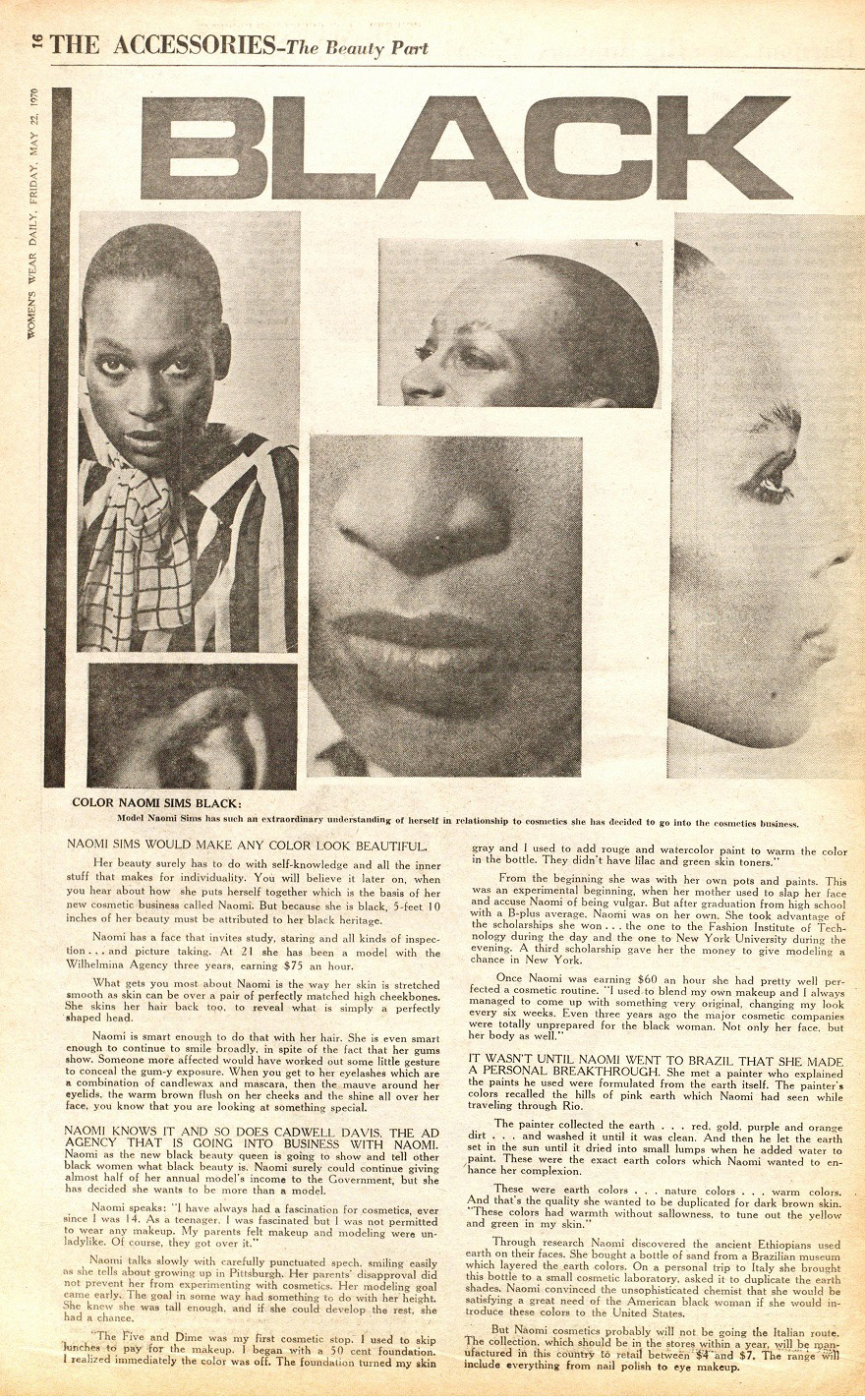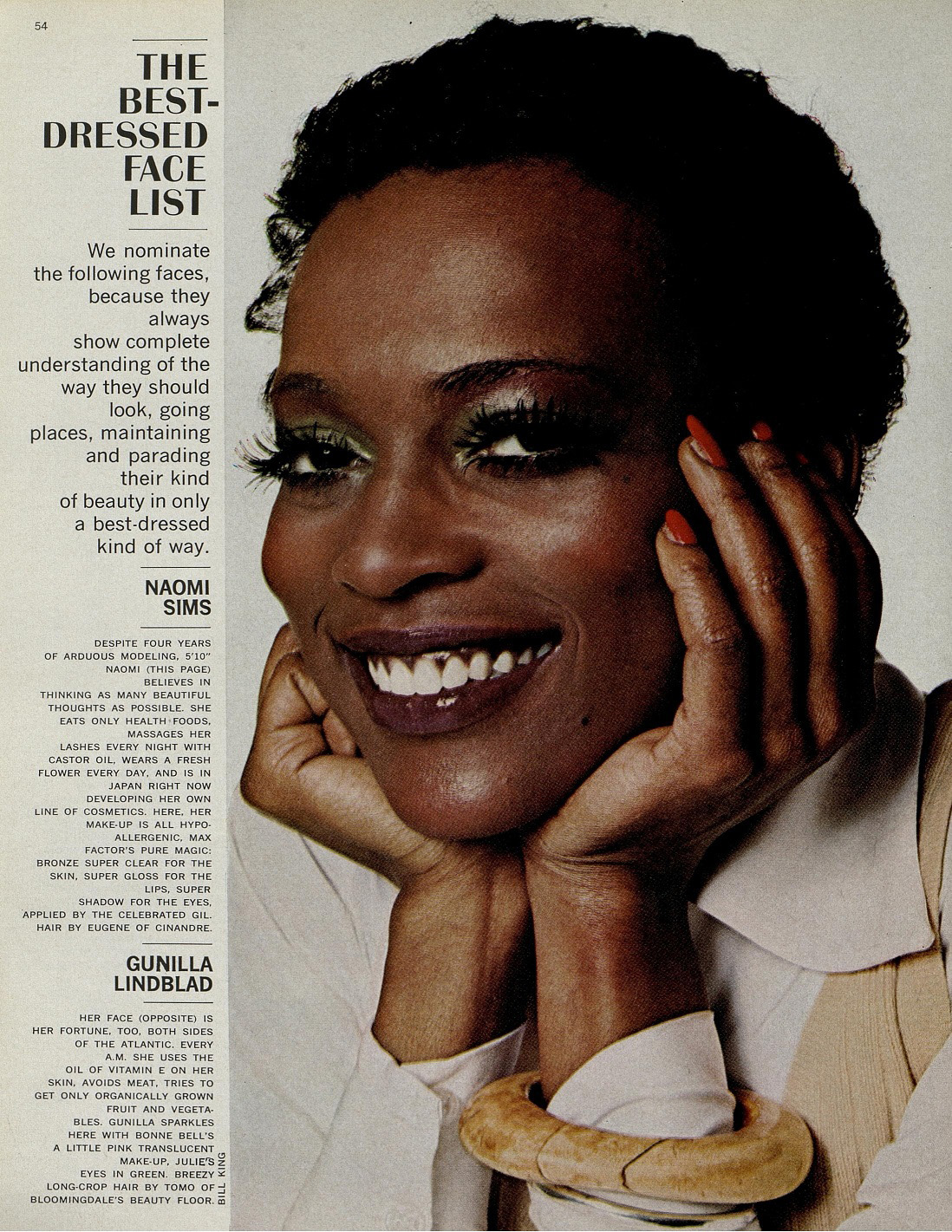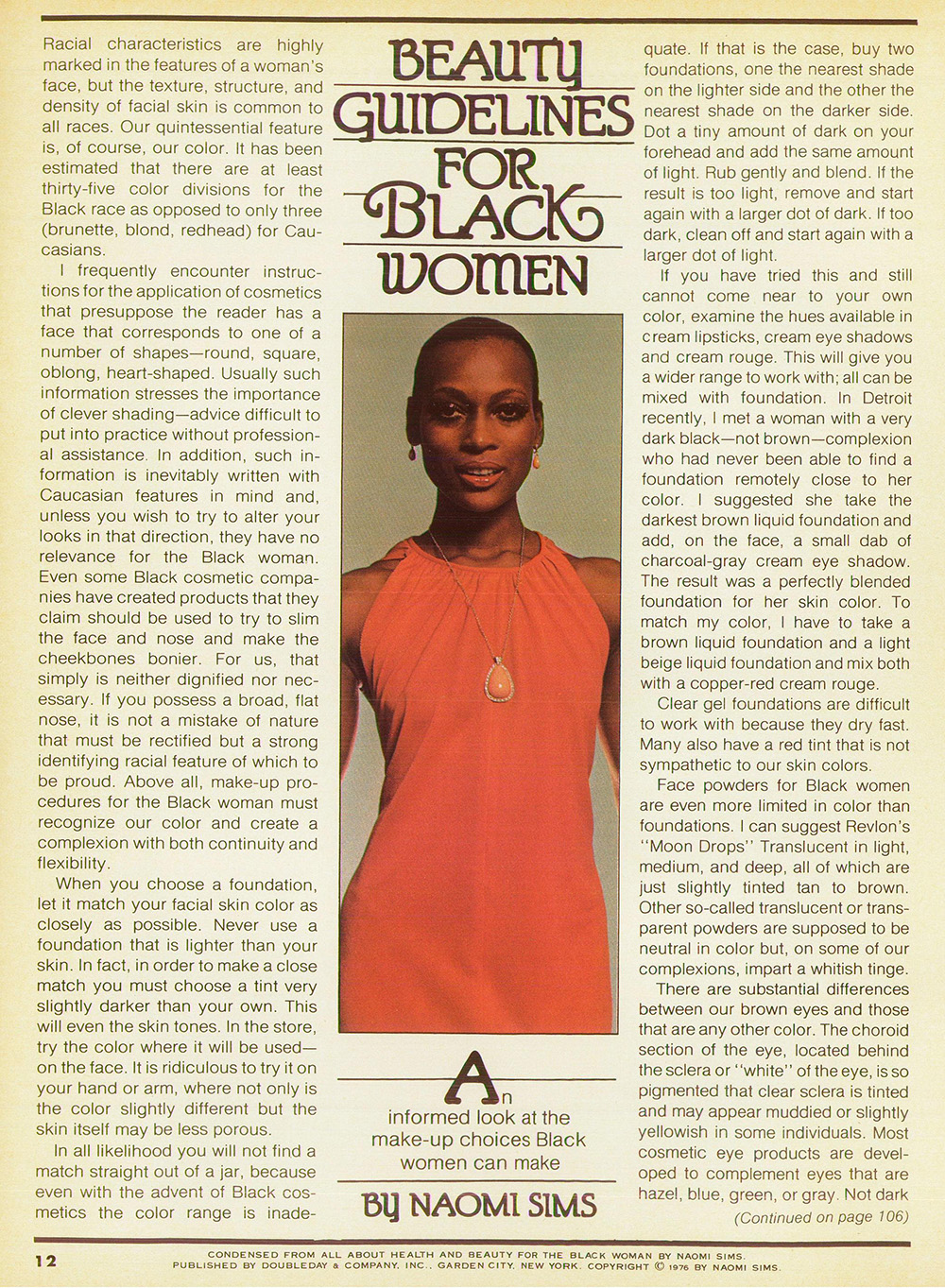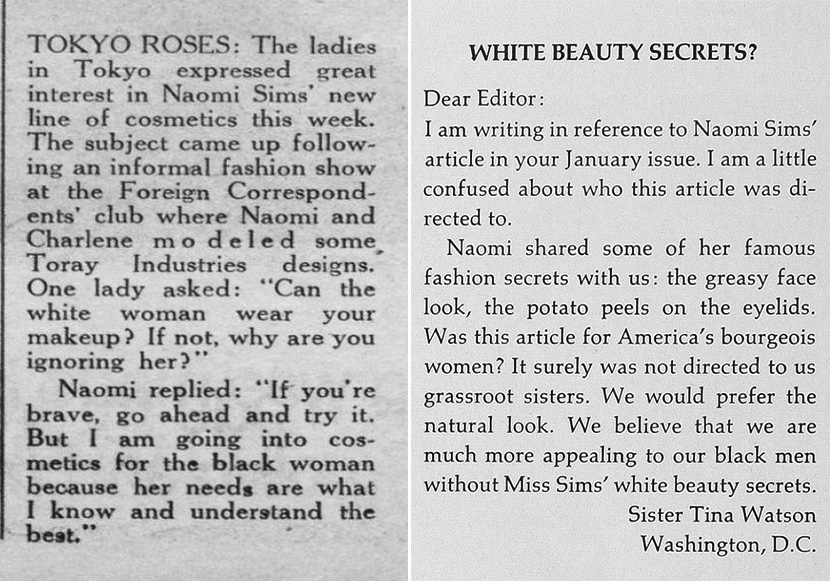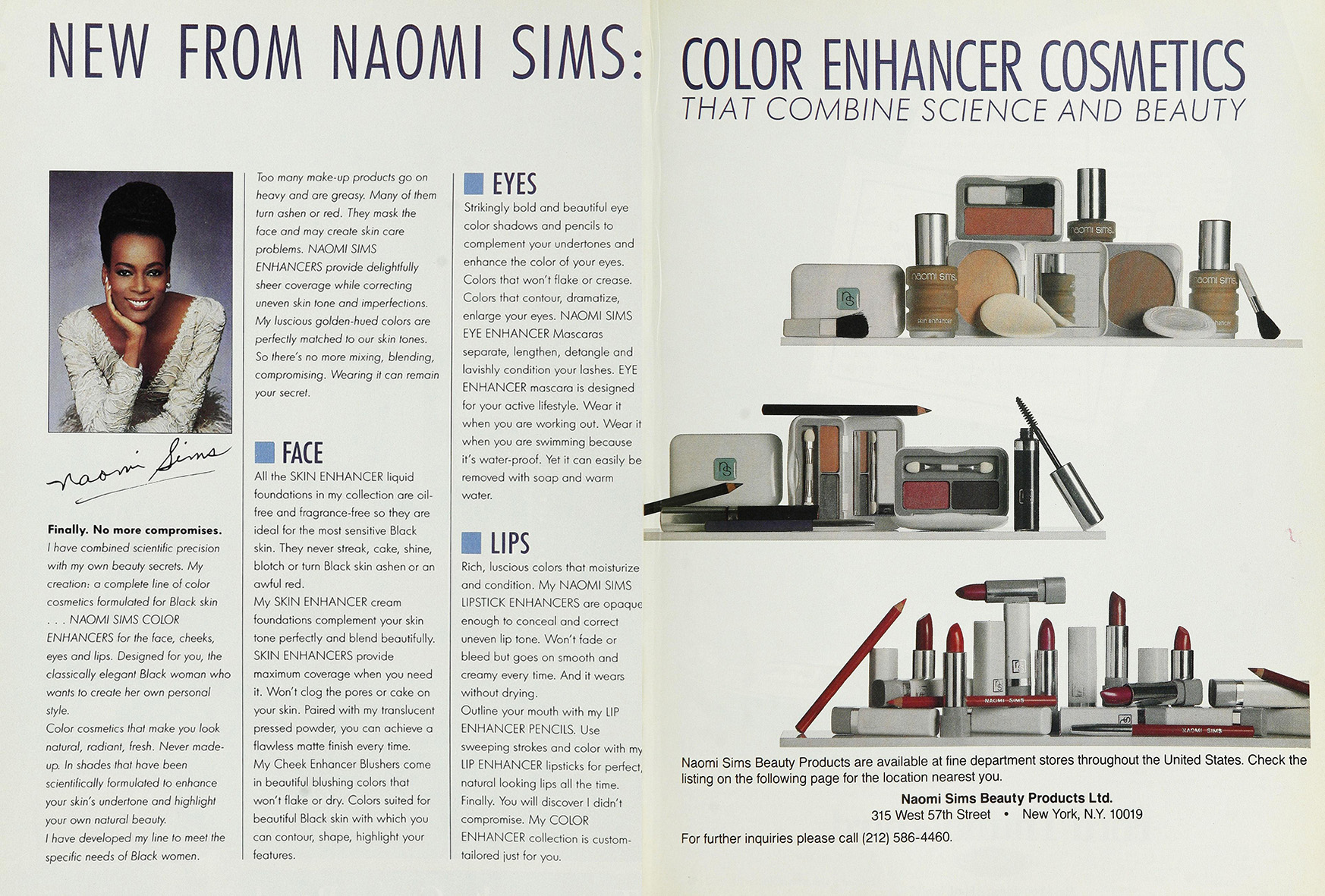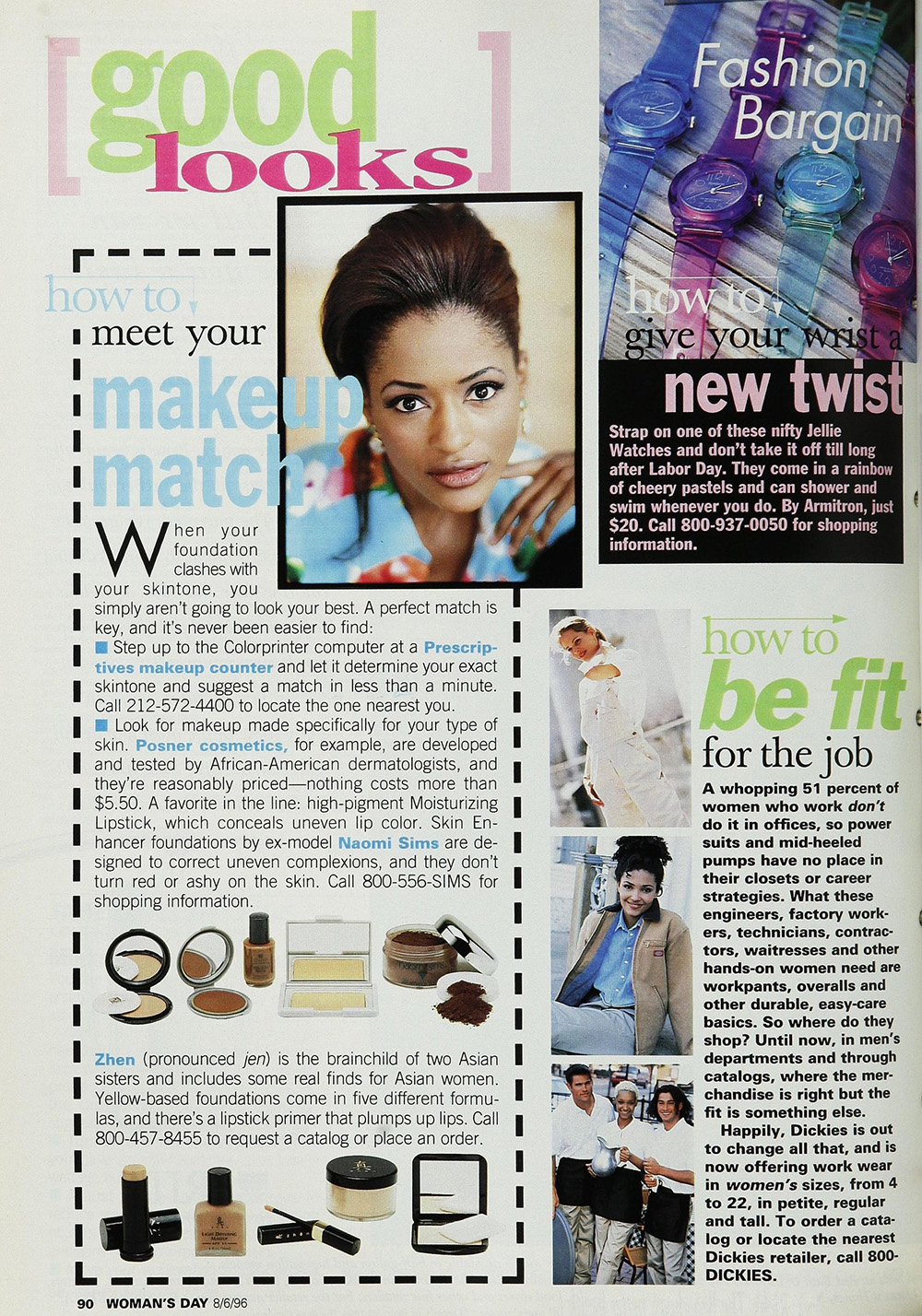It's another incomplete history, but I wanted to highlight the few bits I was able to locate about the makeup line founded by supermodel Naomi Sims, born on this day in 1948.1 (This post will not cover her collection of wigs, fragrance or skincare as these are not technically makeup, nor will it serve as her biography. Also, more light would be probably shed on Sims' intentions for her makeup line if I had remote access to her papers, which are unfortunately available by in-person appointment only. Sigh. Maybe in a few months if it's safe to travel I can dig through her archives and provide a more thorough profile.) Sims, a 5'10" beauty originally from Mississippi, began modeling in 1966 to help pay for college. Her true passion, however, was entrepreneurship. After becoming the first Black model to appear on the cover of Ladies' Home Journal in November 1968 and Life in 1969, Sims focused her attention on various business ventures. "Modeling was never my ultimate goal. Since I was 14 I wanted to manufacture beauty products," she stated.
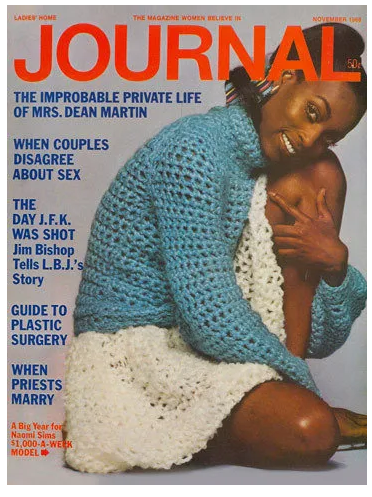
(image from huffpost.com)
On May 15, 1970 Sims announced she would be starting a beauty company that would specialize in cosmetics for Black customers. Like many Black women, Sims was frustrated at the lack of wearable and affordable base products for deep skintones. While a few lines for women of color existed they were not as plentiful or accessible as other brands. Fueled by relentless systemic racism, the barriers to entry for Black beauty entrepreneurs were multiple and substantial – lack of access to capital and loans, discriminatory policies that prohibited their products being sold in most stores2 and the claim that Black women either didn't want/need or couldn't afford makeup were just a handful of the challenges faced by Black entrepreneurs looking to set up shop. In short, despite the significant inroads made by pioneers like Carmen Murphy and Anthony Overton, there weren't many makeup options for Black women. Sims wanted them to feel confident and glamorous, which was difficult given the limited choices. "Black women have an inferiority complex concerning their physical appearance and I want to give them confidence. Black women want the same genuine psychological boost out of cosmetics that other women do, and one simply does not get that glorious feeling of glamour by adding burnt cork to the darkest shade of sun tan powder available," she said.3
The company, called Naomi Inc., was founded in partnership with ad agency Cadwell Davis. The shades were supposedly inspired by a Brazilian painter who used "earth" as a medium. It appears that Sims was nearly a decade ahead of the spate of clay-based products (stay tuned for a post on these!) that would flood the market starting in the late 1970s.
Sims took a keen interest in the formulas, stating that she wanted natural, beneficial ingredients and noted her desire to go back to school for chemistry. "[The] makeup we'll introduce will be almost medical makeup and skincare products. I'll visit stores and tell women how to use them…I want to know really what goes inside those cosmetics."4 As of 1971 the line was still being developed (in Japan), according to Harper's Bazaar.
Plans for the cosmetics were still on the table a year later. (Also, can we please take a minute to appreciate the baby blue on her waterline?! It's a gorgeous twist on the white liner trick to brighten eyes.)
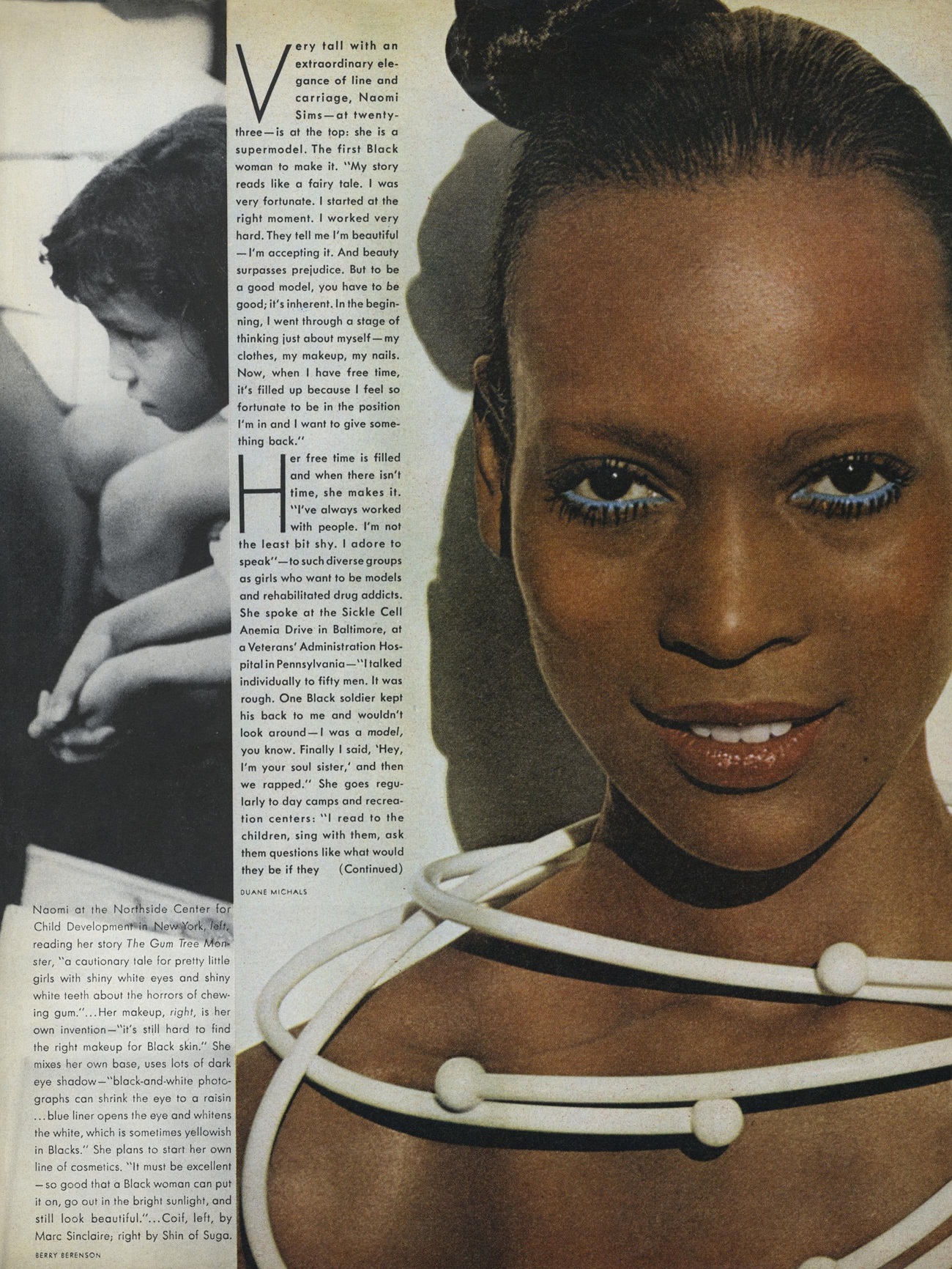
(image from archive.vogue.com)
Rather than continuing with Naomi, Inc., in 1973 Sims largely retired from her modeling career to focus more on her beauty business ventures, debuting a line of wigs called The Naomi Sims Collection. Three years later she published All About Health and Beauty for the Black Woman. While both the beauty guide and wigs sold well, it appears Sims tabled the makeup idea for the time being as there is no mention of it anywhere, not even in her book (or at least, this excerpt that dispenses makeup advice.) One would think someone with her own makeup line would recommend it, but she suggests a Revlon product instead.
In 1978 and at the launch of her fragrance in May 1979, Sims mentioned she was planning both skincare and makeup for the fall, but neither materialized. As of October 1979, according to Vogue, the makeup allegedly was still in development and was slated for a spring/summer 1980 release. "How to find makeup to blend in with our complexion," was still a problem, she noted then. "The colors available just aren't right. And from working with [makeup] every day [while modeling], I wanted to know why someone couldn't develop colors for Black women, and I wouldn't take no for an answer."5 Despite her persistent dedication to establishing a cosmetics range, it seems that the one Sims envisioned in 1970 did not actually come to fruition during that decade. There are several possible reasons as to why she chose to delay it. At first glance, given Sims' access to chemists (whom she worked with to develop new fibers for her wigs) and the overall success of her other endeavors, it's puzzling that she did not forge ahead with makeup. But as we know, makeup, particularly for women of color, has unique hurdles not shared by other beauty product categories. Secondly, early on Sims faced criticism from both white and Black customers. The June 26, 1970 issue of Women's Wear Daily mentions a quote from some Karen who thought it was unfair that Sims' proposed makeup line would cater to Black women (insert eyeroll here), while the April 1971 issue of Essence included a letter from a reader who did not approve of Sims' "white beauty secrets."
The advice from Sims herself was questionable as well. While she encouraged Black women never to minimize full lips, she echoed the sentiment about using makeup to ensure one would be appealing to Black men. "Cosmetics should not minimize the lip shape that many [Black] women have. Cosmetics should bring out the best features in a woman and those include her lips." In the same 1970 article, she advises: "A woman should always use some makeup but it should have a natural look…natural is the way Black men want their women to look."6
Thirdly, it could be that Sims decided she didn't want to compete with other makeup brands or collections intended for Black women at the time. The Naomi Sims Collection launched in 1973, the same year as Fashion Fair Cosmetics. Actress Barbara Walden introduced her eponymous line in 1968, which went on to be sold in department stores two years later. The white-owned Flori Roberts was still going strong, having been established in 1965, and mammoth Avon began marketing to Black women around the same time. Finally, Sims noted that she decided to postpone the line until after the Vietnam War to focus more on makeup. "I think I will wait until the war dies down…there will still be plenty of business left for me," she said.7
Sims never abandoned the idea for makeup products, however. In 1985 she co-founded a new business separate from her wig and fragrance companies, Naomi Sims Beauty Products Ltd., with her brother-in-law Alex Erwiah. Erwiah was a native of the Ivory Coast and a veteran cosmetic marketer who owned a successful import/export company that represented American and European brands throughout Africa. In 1987 a three-step, hypoallergenic skincare system was unveiled. While this sounds awfully similar to Clinique's famous three-step plan, Sims claimed that it was the first allergen-free line formulated especially for Black skin concerns. A year later, the cosmetics line, named Color Enhancers, was finally launched. Advertised as a natural-looking alternative to other cosmetics on the market and specifically formulated for a range of Black skin tones, the products retailed from $7.50 to $18 and were sold via phone order, Macy's, Saks, Nordstrom, Sears and other department stores.8
Sims enlisted makeup artist Byron Barnes to develop the products and join the company as Creative Director.9 Barnes' tenure with Sims was fairly short; in 1993 he left to pursue similar roles for a makeup range founded by another Black supermodel, Iman, which went on to become very successful. On the surface, Naomi Sims Beauty also sold well even early on, with Erwiah anticipating sales of over $5 million in 1989. But later that year he pointed out some challenges faced by the brand. The New York Times reported: "Erwiah calculates that it will be at least two years before Naomi Sims shows a profit. Promotion and penetration of new markets are costly, and the company has invested heavily in new products, adding color cosmetics to its original skin-treatment line. Erwiah has another problem: for reasons that are not clear, Naomi Sims is no longer on the scene. Sims, whose title is chairman of the board, is unavailable for interviews and has no scheduled department store appearances. When asked to describe Sims's current role, Donna Italiano, the company's spokesman, will only say, 'I guess primarily the same as an Estee Lauder. Naomi has established the brand, and now she has taken pretty much of a back seat. Alex is the sole owner and Naomi Sims collects royalties.' Italiano does confirm that Sims has been ill and was recently hospitalized in Manhattan. While some observers question whether Naomi Sims Beauty Products can succeed, absent a compelling, credible figure with whom black women can identify, others declare that the day of beauty queens like Estee Lauder has passed. 'Today's cosmetics companies are selling image more than personality,' says consultant Natalia Holynskyj of Kline & Co., a market research firm in Fairfield, N.J. 'Even Estee Lauder has changed. The company doesn't use the Lauder name with its Clinique and Prescriptives lines.'"
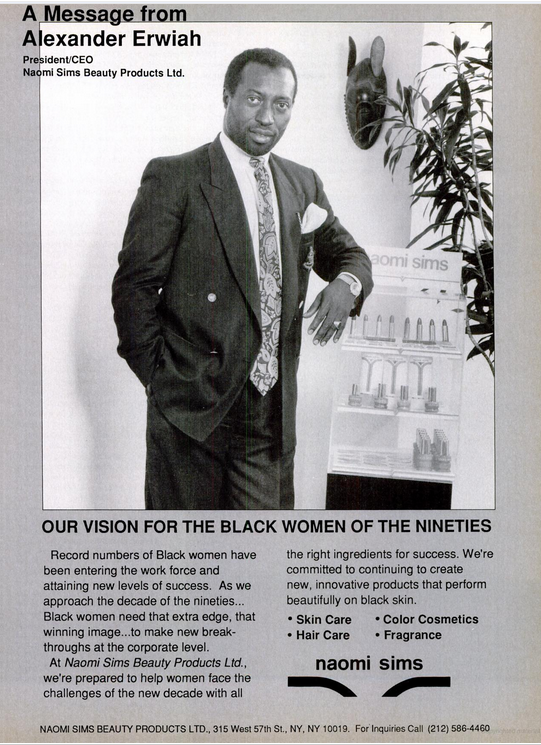
(image from books.google.com)
Despite these obstacles, in 1992 the collection was doing well enough to launch in the UK, and was still being promoted through the summer of 1996.
That summer the company released a eyeshadow primer called Chalk. This is quite innovative due to the fact that there were basically next to zero eyeshadow primers on the market at the time (I distinctly remember being advised to use concealer or a matte beige/ivory shadow applied wet as a base), and the ones that were available certainly were not formulated for deep skin tones. "While most [eyeshadow primers] come in a sharp white, Naomi Sims' is a banana yellow that blends better with darker skin and helps colors appear more vibrant," reported the L.A. Times.10 Yellow toned or not, it was a strange name choice given that a common problem with eyeshadow primers is that they can appear quite chalky on dark skin. In November of 1996, an article in Drug and Cosmetic Industry cited two makeup artists who raved about both Naomi Sims skincare and the Skin Enhancer foundation. The same issue featured an interview with Mikki Taylor, then beauty and cover editor of Essence, who called the line "superb". But despite these accolades, the makeup didn't seem to be around much longer. While hair and skincare products from Naomi Sims Beauty Products were available in 2003, the makeup line appears to have been abruptly discontinued in late 1996 as I couldn't find any mentions of it thereafter.
It's not clear when Naomi Sims Beauty officially folded.11 What we do know, however, is that Sims was yet another visionary for Black women's cosmetics. Without models/seasoned businesswomen like Sims, who had first-hand experience with the issues surrounding beauty aids for Black women as well as Black entrepreneurship more generally, even less ground would have been covered by now in terms of suitable cosmetics for Black customers. I think the fact that her line was relatively short-lived and not as well-known compared to other Black-owned brands had nothing to do with product quality, marketing or the public's perception of Sims, given that her wigs were very popular for many years and her beauty guide sold even more copies when it was updated and republished in 1986, a decade after after its original run. I suspect it was related to heavy competition from the flurry of new, "multicultural" collections by mainstream white-owned brands in the early '90s (such as Maybelline's Shades of You, Prescriptives All Skins, and Revlon's ColorStyle, just to name a few – stay tuned for a post on these too!), revamped heritage Black-owned brands (Fashion Fair, Posner) and stylish newcomers like Iman. Nothing about Color Enhancers appeared to be lacking. It was simply unfortunate timing. And, of course, the role played by racism cannot be overstated.
What do you think? I really wish I could track down some of the makeup for the Museum's collection, but I found no trace of it offered for sale.
1Some sources indicate 1949, but Sims's obituary states she was 61 at the time of her death, so that would mean her birth year was 1948.
2Most brands that catered to Black customers were only sold via mail order or direct sales (i.e. door-to-door sales agents.)
3"Beauty Plan – Color It Black," Associated Press, May 16, 1970.
4"Top Model Naomi Sims Has Personality Plus," Courier Journal, Louisville, Kentucky, December 3, 1970.
5"Naomi Sims Brings Preview of Her Wig Designs to County," Joan Tarangioli, The Herald Statesman, Yonkers, New York, October 21, 1979.
6"Beauty Plan – Color It Black," Associated Press, May 16, 1970.
7"Everybody Is A Winner in Black Cosmetics War," Nina S. Hyde, Washington Post, July 1977.
8"New Beauty Lines Cater to Special Needs, Problems of Darker Skin Tones," Marylin Johnson, Atlanta Constitution, January 1, 1989.
9Barnes indicated he began working with Sims in 1989; however, the August 1988 issue of Seventeen lists him as the brand's creative director.
10"Changing Their Tones," Jocelyn Y. Stewart, L.A. Times, June 6, 1996.
11Interestingly, there is a 2016 trademark for Naomi Sims Beauty filed under Alex Erwiah's name, 7 years after Sims passed away.


